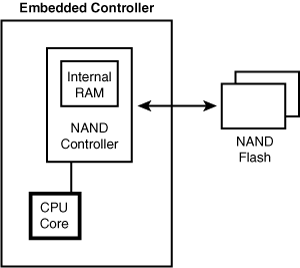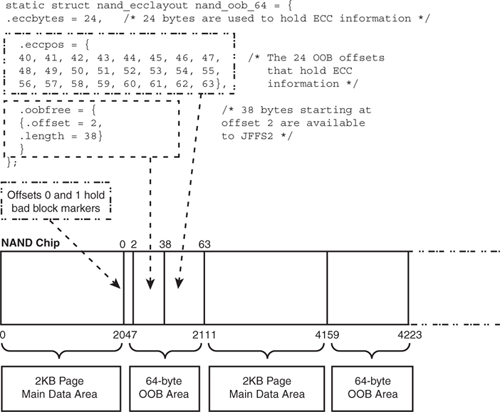Understanding Memory Technology Devices in Embedded Linux
转:
NAND Chip Drivers
NAND technology users such as USB pen drives, DOMs, Compact Flash memory, and SD/MMC cards emulate standard storage interfaces such as SCSI or IDE over NAND flash, so you don't need to develop NAND drivers to communicate with them.5 On-board NAND flash chips need special drivers, however, and are the topic of this section.
As you learned previously in this chapter, NAND flash chips, unlike their NOR counterparts, are not connected to the CPU via data and address lines. They interface to the CPU through special electronics called a NAND flash controller that is part of many embedded processors. To read data from NAND flash, the CPU issues an appropriate read command to the NAND controller. The controller transfers data from the requested flash location to an internal RAM memory, also part of the controller. The data transfer is done in units of the flash chip's page size (for example, 2KB). In general, the denser the flash chip, the larger is its page size. Note that the page size is different from the flash chip's block size, which is the minimum erasable flash memory unit (for example, 16KB). After the transfer operation completes, the CPU reads the requested NAND contents from the internal RAM. Writes to NAND flash are done similarly, except that the controller transfers data from the internal RAM to flash. The connection diagram of NAND flash memory on an embedded device is shown in Figure 17.3.

Figure 17.3 NAND flash connection.
Because of this unconventional mode of addressing, you need special drivers to work with NAND storage. MTD provides such drivers to manage NAND-resident data. If you are using a supported chip, you have to enable only the appropriate low-level MTD NAND driver. If you are writing a NAND flash driver, however, you need to explore two datasheets: the NAND flash controller and the NAND flash chip.
NAND flash chips do not support automatic configuration using protocols such as CFI. You have to manually inform MTD about the properties of your NAND chip by adding an entry to thenand_flash_ids[] table defined in drivers/mtd/nand/nand_ids.c. Each entry in the table consists of an identifier name, the device ID, page size, erase block size, chip size, and options such as the bus width.
There is another characteristic that goes hand in hand with NAND memory. NAND flash chips, unlike NOR chips, are not faultless. It's normal to have some problem bits and bad blocks scattered across NAND flash regions. To handle this, NAND devices associate a spare area with each flash page (for example, 64 bytes of spare area for each 2KB data page). The spare area contains out-of-band (OOB) information to help perform bad block management and error correction. The OOB area includes error correcting codes (ECCs) to implement error correction and detection. ECC algorithms correct single-bit errors and detect multibit errors. The nand_ecclayout structure defined ininclude/mtd/mtd-abi.h specifies the layout of the OOB spare area:
struct nand_ecclayout {
uint 32_t eccbytes;
uint32_t eccpos[64];
uint32_t oobavail;
struct nand_oobfree oobfree[MTD_MAX_OOBFREE_ENTRIES];
};
In this structure, eccbytes holds the number of OOB bytes that store ECC data, and eccpos is an array of offsets into the OOB area that contains the ECC data. oobfree records the unused bytes in the OOB area available to flash filesystems for storing flags such as clean markers that signal successful completion of erase operations.
Individual NAND drivers initialize their nand_ecclayout according to the chip's properties. Figure 17.4illustrates the layout of a NAND flash chip having a page size of 2KB. The OOB semantics used by the figure is the default for 2KB page-sized chips as defined in the generic NAND driver,drivers/mtd/nand/nand_base.c.

Figure 17.4 Layout of a NAND flash chip.
Often, the NAND controller performs error correction and detection in hardware by operating on the ECC fields in the OOB area. If your NAND controller does not support error management, however, you will need to get MTD to do that for you in software. The MTD nand_ecc driver (drivers/mtd/nand/nand_ecc.c) implements software ECC.
Figure 17.4 also shows OOB memory bytes that contain bad block markers. These markers are used to flag faulty flash blocks and are usually present in the OOB region belonging to the first page of each block. The position of the marker inside the OOB area depends on the properties of the chip. Bad block markers are either set at the factory during manufacture, or by software when it detects wear in a block. MTD implements bad block management in drivers/mtd/nand/nand_bbt.c.
The mtd_partition structure used in Listing 17.1 for the NOR flash in Figure 17.2 works for NAND memory, too. After you MTD-enable your NAND flash, you can access the constituent partitions using standard device nodes such as /dev/mtd/X and /dev/mtdblock/X. If you have a mix of NOR and NAND memories on your hardware, X can be either a NOR or a NAND partition. If you have a total of more than 32 flash partitions, accordingly change the value of MAX_MTD_DEVICES ininclude/linux/mtd/mtd.h.
To effectively make use of NAND storage, you need to use a filesystem tuned for NAND access, such as JFFS2 or YAFFS2, in tandem with the low-level NAND driver. We discuss these filesystems in the next section.
Understanding Memory Technology Devices in Embedded Linux的更多相关文章
- Linux MTD (Memory Technology Device) subsystem analysis -For Atheros char device
Linux MTD (Memory Technology Device) subsystem analysis For Atheros char device 读了Linux MTD 源代码分析 对这 ...
- (转)Understanding Memory in Deep Learning Systems: The Neuroscience, Psychology and Technology Perspectives
Understanding Memory in Deep Learning Systems: The Neuroscience, Psychology and Technology Perspecti ...
- 【转载】关于Embedded Linux启动的经典问题
转载自:http://linux.chinaunix.net/techdoc/install/2009/04/13/1107608.shtml 发信人: armlinux (armlinux), 信区 ...
- Understanding Memory Management(2)
Understanding Memory Management Memory management is the process of allocating new objects and remov ...
- Qt for Embedded Linux
1. Qt for Embedded Linux http://doc.qt.io/qt-5/embedded-linux.html 2. Installing Qt for Embedded Lin ...
- 构建自己的embedded linux系统
[教程]使用buildroot完全自定义自己的embedded linux系统(nand)http://www.eeboard.com/bbs/thread-38377-1-1.html [教程] [ ...
- [转]A Guide To using IMU (Accelerometer and Gyroscope Devices) in Embedded Applications.
原文地址http://www.starlino.com/imu_guide.html Introduction There’s now a FRENCH translation of this art ...
- Memory Leak Detection in Embedded Systems
One of the problems with developing embedded systems is the detection of memory leaks; I've found th ...
- How to Add Memory, vCPU, Hard Disk to Linux KVM Virtual Machine
ref: https://www.thegeekstuff.com/2015/02/add-memory-cpu-disk-to-kvm-vm/ In our previous article of ...
随机推荐
- GCC特性之__init修饰解析 - kasalyn的专栏 - 博客频道 - CSDN.NET
, GCC特性之__init修饰解析 - kasalyn的专栏 - 博客频道 - CSDN.NET.MathJax_Hover_Frame {border-radius: .25em; -webkit ...
- node+express+nginx搭建站点
window系统 1.安装node 2.新建文件夹test 3. cmd 命令行 cd test 进入test文件夹下 输入命令:npm -v查看版本 确认node是否安装成功 4.npm init ...
- nyoj 题目21 三个水杯
三个水杯 时间限制:1000 ms | 内存限制:65535 KB 难度:4 描述 给出三个水杯,大小不一,并且只有最大的水杯的水是装满的,其余两个为空杯子.三个水杯之间相互倒水,并且水杯没有 ...
- hexo 添加标签
--- title: title #文章標題 date: 2016-06-01 23:47:44 #文章生成時間 categories: "Hexo教程" #文章分類目錄 可以省略 ...
- pagination用法
pagination用法: 1.html 要用两层div <script src="${app }/pc/js/media/pagination.js"></s ...
- 一种机制,与js类似
我们知道,当两个条件进行逻辑与操作的时候,其中任何一个条件为假,则表达式的结果为假.所以,遇到(A 且 B)这种表达式,如果A为假的话,B是不是真假都无所谓了,当遇到一个假条件的时候,程序也就没有必要 ...
- Python数据结构——栈
栈是一种特殊的列表,栈内的元素只能通过列表的一端访问,这一端称为栈顶.栈被称为一种后入先出(LIFO,last-in-first-out)的数据结构. 由于栈具有后入先出的特点,所以任何不在栈顶的元素 ...
- 基于Xen实现一种domain0和domainU的应用层数据交互高效机制 - 3
继续 上一篇 的研究,结合 xen4.2.3 的代码分析,发现 xen4.2.3 的应用层工具库 tools 包含一个工具叫 libvchan ,其头文件描述如下: * This is a libra ...
- Error:Execution failed for task ':app:transformClassesWithDexForDebug'. > com.android.build.api.transform.TransformException: com.android.ide.common.process.ProcessException: java.util.concurrent.Exec
Error:Execution failed for task ':app:transformClassesWithDexForDebug'.> com.android.build.api.tr ...
- C# Quartz 整理
因项目需要,在C#中使用了定时程序.自然就使用了Quartz了 但是使用的时候,经过一段时间后,发现了两个重大问题,结果导致的是一样的,就是都导致了定时不会继续执行了. 第一个问题是,定时程序发布在I ...
